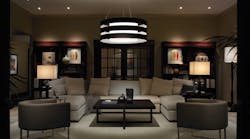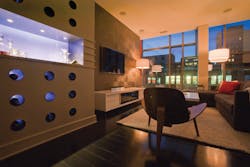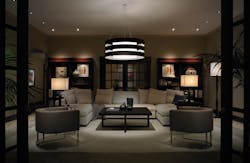By Tom Perich, Director of Marketing, Lutron Electronics
Five years ago, the concept of a smart home may not have been on the minds of most consumers. But that’s changed. According to the Consumer Technology Association (CTA), consumers are expected to spend $4.6 billion on smart home products and technologies in 2019. And don’t expect to see a slowdown any time soon. In fact, Mordor Intelligence projects nearly 30 million U.S. households will add smart home technology in the near future.
There’s been a major shift in consumer sentiment toward smart home products over the last five years. Initially, consumers viewed smart home products as “gimmicky” or only for couch potatoes. As more smart home products were introduced into the market and started working together to enhance the in-home experience, consumers slowly overcame the gimmick aspect and started to see their true value. Fast forward to today, where people are using smart home products to solve problems, simplify daily routines, and gain peace of mind. So where does a consumer begin? The good news for contractors and distributors is that for most, the answer is smart lighting.
Smart lighting is an obvious starting place because one, lights are arguably the most used thing in your home and two, peace of mind tops the list of smart lighting benefits. For example, from an app, lights can be scheduled to turn on at dusk and off at dawn, can automatically turn on as you approach your home, and can be randomized to mimic occupancy while away on vacation. There’s no greater feeling than peace of mind — and it can be achieved with smart lighting systems that start at under $200 in material cost. This low cost of entry provides contractors with an opportunity to add value in installation and programming support, while still making a smart lighting upgrade affordable for consumers.
THE BASIC SMART LIGHTING PRODUCTS
Smart light bulbs, dimmers and inter-connected group of dimmers and switches are the core of most smart lighting installations. Following are some brief definitions of each.
Smart light bulb. An internet-capable LED light bulb that allows lighting to be customized, scheduled and controlled remotely. Applications typically limited to one or two rooms or key areas.
Smart dimmer. A dimmer that’s internet-capable and can be customized, scheduled and controlled remotely. It may or may not be part of a larger smart lighting system.
Smart lighting system. A group of internet-connected dimmers and switches. Smart lighting control systems are connected to the internet via a central hub or bridge in the home, allowing lights to be customized, scheduled and controlled remotely. Smart lighting systems are scalable and can be used in key areas of the home or can scale to do the entire home. Smart lighting systems work with other devices such as cameras, automated shades, speakers, thermostats, smoke detectors, and more to enhance the user experience.
LINKING SMART LIGHTING WITH OTHER SYSTEMS
It’s easy to see why smart lighting should be the building block of the home. Today, it’s easier than ever to connect smart home products to each other and enhance the in-home experience. Smart lighting systems can be tied to things like smart cameras, smoke detectors, thermostats, speakers and security systems, giving homeowners even more value. For example, a smart thermostat that’s tied to the smart lighting system can auto adjust the temperature when the lighting system tells it the house is empty.
Smart home adoption is being driven not only by the value of product interoperability, but also the growing interest in smart speakers such as Amazon Echo, Google Assistant and Apple HomePod. According to CTA, 31% of U.S. households own a smart speaker, which nearly doubled from 2018. Giving homeowners the ability to control lights with their voice is a strong selling point. For example, saying, “Alexa, good morning,” to your Amazon Echo smart speaker will adjust lights, automated window shades, temperature and music to preset levels. It’s that easy.
MORE REVENUE FOR YOU
We’ve already established that consumers want smart home solutions. That means you need to be able to fulfill the increased demand from the contractors’ customers. If you can’t, those contractors will go somewhere else to make their purchase.
There are also significantly more top- and bottom-line dollars to be had with smart home solutions. Selling one $159 smart home kit and eight additional $50 dimmers is much better for your business than selling traditional wall switches.
If you’re not stocking smart home solutions, you’re not staying current with market trends and you’re missing out on a massive revenue opportunity, for both you and your contractors.
KEEP EXPANDING
Once you’ve added smart lighting control to your business, don’t stop the momentum. Consider investing in/stocking other smart home solutions that go together with smart lighting control, such as smart thermostats, doorbells, and locks. These solutions provide a low-barrier entry into smart home for the contractor and will serve to keep driving your smart home business forward.
There’s never been a greater opportunity for business expansion like there is right now with smart home.
As director of Channel Marketing – Electrical Wholesale for Lutron Electronics, Tom Perich focuses on the company’s C.L dimmers and accessories, sensors, Caséta by Lutron, Ra2 Select, and Vive Wireless Lighting Control products. He can be reached at [email protected].
SIDEBAR: 8 Tips for Getting Started in Smart Lighting
The prospect of expanding into smart home solutions via smart lighting control doesn’t have to be overwhelming. Here are eight tips to help you get off to a good start.
1. Become the leader in smart home information for your contractors. Take the time to learn about, and then stay updated on, trends in smart lighting control as well as smart home trends in general. Regularly read trade publications, check out online forums/articles, and talk to your rep about what’s current.
2. Partner with the right smart lighting control manufacturer. You want to choose a company whose products can be easily integrated with other smart devices. When best-in-class brands have interoperable products, it’s likely that the manufacturers will be working hard to make continuous product improvements to address customer needs.
3. Get product in all of your relevant branches. Committing to the category means having product available for your contractors to buy whenever they walk in the door. Your team doesn’t want to have to tell a contractor that the product will be there in two days. And if you don’t have what the contractor wants, he’ll go elsewhere that day to get it.
4. Make sure you order enough stock for each branch. When thinking about stock, consider how large a smart lighting control job needs to be to give the consumer a great experience. A good rule of thumb is eight or more dimmers and a bridge or hub (for integration) per job.
5. Set up training with your local rep agency for your in-branch staff, and then make regular training a priority. The better educated your staff are on the smart lighting control solutions you stock, the better they’ll be able to answer contractor questions. You should also visit manufacturers’ web sites for online trainings that staff can take when it best suits them.
6. Keep your in-branch staff engaged, as they’re the ones talking to contractors every day. Continually communicate and incentivize them to stay on top of trends in smart lighting control and where you see your business going.
7. Set up regular training for your contractors. The better educated they are about the product and its benefits, the more inclined they’ll be to suggest it to customers. Reach out to your reps to help facilitate contractor in-branch training conducted by manufacturers. To help your contractors be more successful, ask your reps to host ongoing smart home updates where they can learn about trends and keep an eye on what’s next.
8. Get sample product for both your team and your contractors, so they can install and live with it in their own homes. Using what they’re selling and understanding first-hand how the product works gives them real-life examples to share when promoting the solution.











